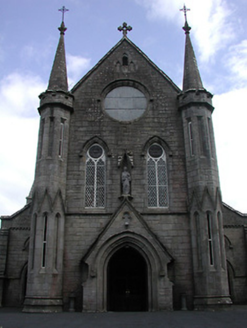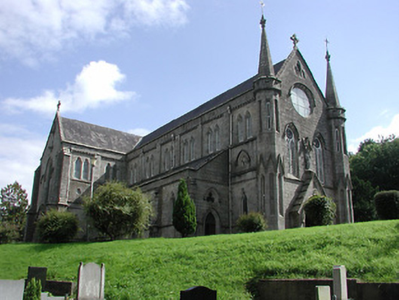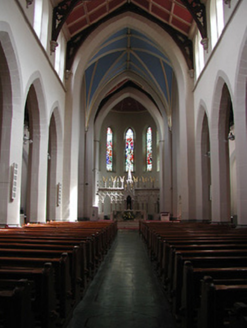Survey Data
Reg No
22303092
Rating
Regional
Categories of Special Interest
Architectural, Artistic, Social
Original Use
Church/chapel
In Use As
Church/chapel
Date
1850 - 1860
Coordinates
213538, 188964
Date Recorded
27/08/2004
Date Updated
--/--/--
Description
Freestanding cruciform-plan Catholic church, built c.1855, comprising gable-fronted six-bay nave with side aisles, two-bay transepts, single-bay chancel with bow-plan apse to east and with L-plan sacristy to south-east. West front has shallow gable-fronted porch to centre with order arch and with statue over and is flanked by polygonal turrets with narrow round and square-headed lights and blind lights, crenellations and spirelets. Pitched artificial slate roofs with mono-pitched roofs to aisles, flat roof to sacristy and with stone cross finials to gables. Snecked sandstone walls, rubble to exterior of side aisles, with string courses, modillions and buttresses. Trefoil-headed windows to aisles, paired to clerestorey, lancets to apse, large round and pointed-arch windows with hood-mouldings to west front, and with some trefoil windows with hood-mouldings. Stained glass to windows in east and west ends. Pointed-arch openings with timber battened double-leaf doors with stone hood-mouldings. Blind door and window openings to east elevation. Interior has arcade of polygonal columns supporting pointed arches, roof of braced wooden trusses with decorative cast iron to spandrels and with ornamental marble screen in apse.
Appraisal
Saint Cronan's Church is a large-scale, impressive urban church that forms a very significant part of Roscrea's townscape. It has evident well-executed stonework with a host of architectural details to the exterior. The elegant buttresses to the corners add further monumentality to the composition. Its location, on pleasantly landscaped rising ground, adds much to the siting. The variety of carved work and window forms enliven the façade. Internally sturdy arcading leads to a well-preserved carved stone reredos that forms a decorative focus for the building. The stained glass and other decorative features add further artistic and technical interest, while the medieval friary remains add archaeological interest to the setting.





